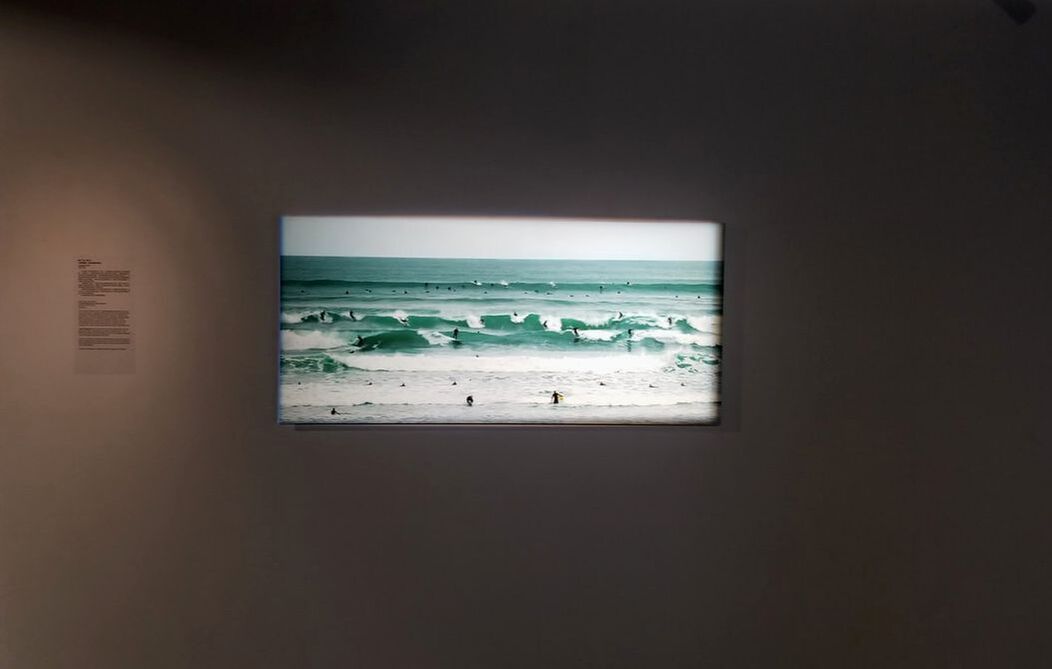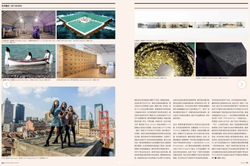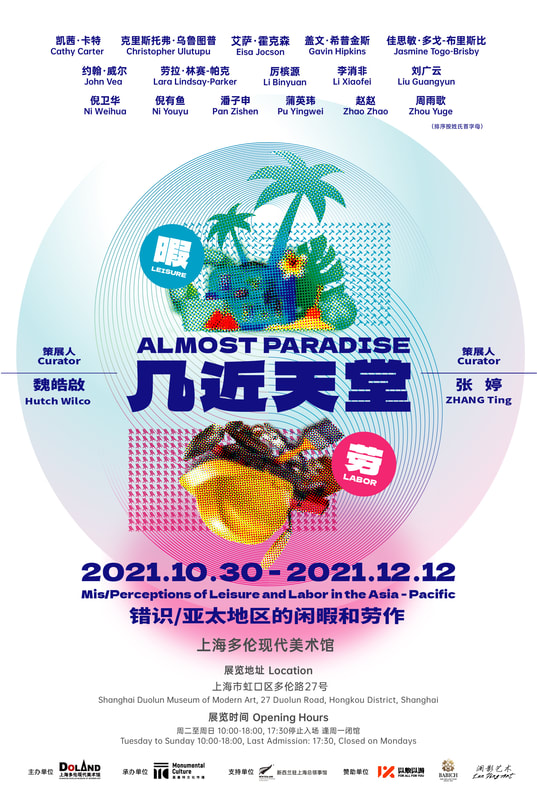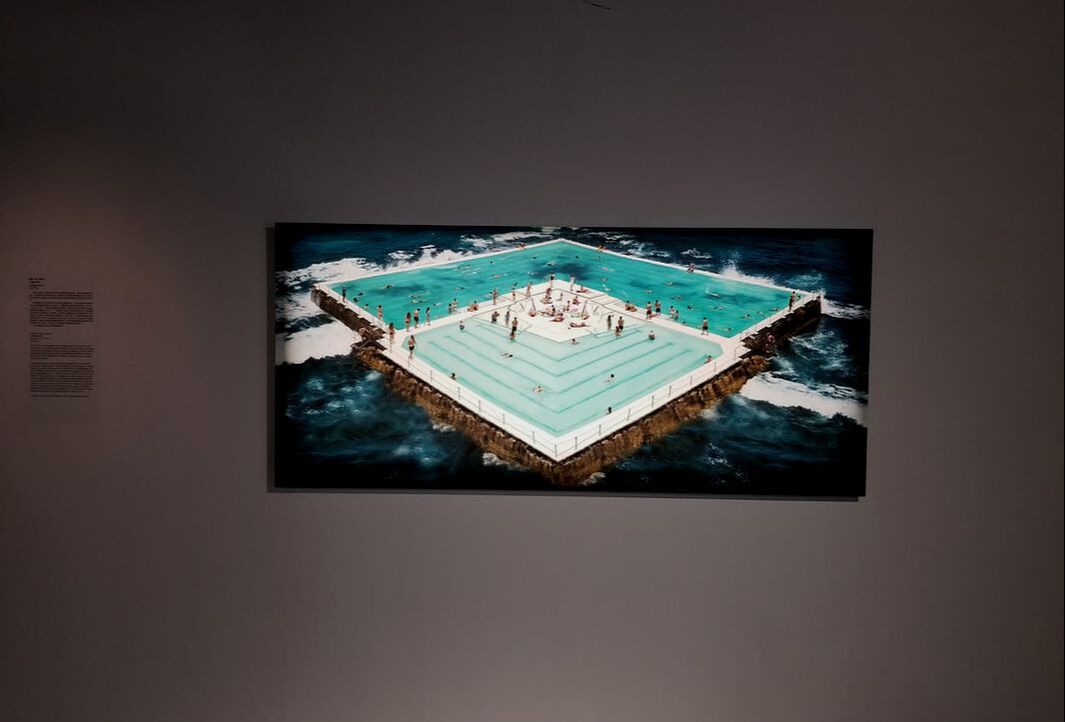‘Icebergs 2018’, Explores boundaries between the natural and the cultural, liminal spaces and forms that are both and neither.’ (D, Campany ed, Art and Photography, Phaidon, 2008). Bondi Icebergs Pool, inspired the idea of such a space. A place cut off from land as its name suggests and being both natural and unnatural.
This work is part of a continuing series in which the viewer is positioned as ‘arial voyeur’. This is an inherently contemporary, drone-like perspective that references the growing detachment of urban life to nature both physically and psychologically, in the face of technology’s increasing encroachment on our everyday lives.
The work also draws on Alberto Giacometti’s observation: ‘ The object of art is not to reproduce reality, but to create a reality of the same intensity’ . The work seeks to be both otherworldly and completely of this world exploring photography’s inherent ability as a representation of reality, to create alternate worlds and in doing so to question our perceptions and to posit a futuristic possibility in which rising sea levels may isolate and cut off coastal communities. To create this space of illusion Carter used digital collaging in photoshop.
Time has also been manipulated through the repetition of figures within the photograph. This was done to make visual the relativities of time and space often experienced on vacation, the seeming slowness of time spent relaxing, and the repetitive movement of people between and through this fluid space. It also attempts to make visual the sense of being in the moment when we are by or in spaces of water, to some degree this perhaps is attributable to a lack or reduction of technology in these spaces, which provides a sense of immediacy with the immediate surroundings.
There are many dynamics at play within this sensual space of pleasure and performance. The work examines the relaxation, physical exercise but also the absurdity and vulnerability of humanity within spaces of water.
This work is part of a continuing series in which the viewer is positioned as ‘arial voyeur’. This is an inherently contemporary, drone-like perspective that references the growing detachment of urban life to nature both physically and psychologically, in the face of technology’s increasing encroachment on our everyday lives.
The work also draws on Alberto Giacometti’s observation: ‘ The object of art is not to reproduce reality, but to create a reality of the same intensity’ . The work seeks to be both otherworldly and completely of this world exploring photography’s inherent ability as a representation of reality, to create alternate worlds and in doing so to question our perceptions and to posit a futuristic possibility in which rising sea levels may isolate and cut off coastal communities. To create this space of illusion Carter used digital collaging in photoshop.
Time has also been manipulated through the repetition of figures within the photograph. This was done to make visual the relativities of time and space often experienced on vacation, the seeming slowness of time spent relaxing, and the repetitive movement of people between and through this fluid space. It also attempts to make visual the sense of being in the moment when we are by or in spaces of water, to some degree this perhaps is attributable to a lack or reduction of technology in these spaces, which provides a sense of immediacy with the immediate surroundings.
There are many dynamics at play within this sensual space of pleasure and performance. The work examines the relaxation, physical exercise but also the absurdity and vulnerability of humanity within spaces of water.

Liquid Playground, Piha Surfers, 2021
This work is part of Carter’s ‘Seaside Series’ which positions the viewer as ‘aerial voyeur’, providing a detachment to examine the absurdity and vulnerability of human activity within a space of visceral pleasure and escapism and danger. Piha is one of Aotearoa’s iconic surfing sites which attracts visitors from all over the world. Part of the surfing identity is the sense of freedom this activity provides, an escape from the everyday, and a return to a time and place removed form digital technology.
‘Liquid Playground’ was constructed by blending several images taken over a period of time on a grey, winter’s day. Carter has repeated figures of surfers on different waves. This both mimics congestion on the often-crowded breaks, as well as visualizing the relativities of time and space experienced within this sublime liquid space.
Carter’s work references artists like Richard Misrach and Andreas Gursky in posing questions about our interactions with bodies of water, and exploring what these interactions mean both for our interior, personal worlds as well as our consumerist cultural and social structures in a world ever-more-impacted by our ‘guardianship’.
This work is part of Carter’s ‘Seaside Series’ which positions the viewer as ‘aerial voyeur’, providing a detachment to examine the absurdity and vulnerability of human activity within a space of visceral pleasure and escapism and danger. Piha is one of Aotearoa’s iconic surfing sites which attracts visitors from all over the world. Part of the surfing identity is the sense of freedom this activity provides, an escape from the everyday, and a return to a time and place removed form digital technology.
‘Liquid Playground’ was constructed by blending several images taken over a period of time on a grey, winter’s day. Carter has repeated figures of surfers on different waves. This both mimics congestion on the often-crowded breaks, as well as visualizing the relativities of time and space experienced within this sublime liquid space.
Carter’s work references artists like Richard Misrach and Andreas Gursky in posing questions about our interactions with bodies of water, and exploring what these interactions mean both for our interior, personal worlds as well as our consumerist cultural and social structures in a world ever-more-impacted by our ‘guardianship’.

"Almost Paradise" , Art Review in "Art and Design China" Magazine
In 2020, Shanghai Duolun Museum of Modern Art invited New Zealand curator Hutch Wilco and China's Zhang Ting to curate "Southern Transmissions: Contemporary Video Art from Oceania", The dynamic ethnography of the island's aborigines is presented to the audience, leading the public into the landscape of contemporary art in Oceania. China and Oceania and the chain of islands in between, these regions in the pan-Asia-Pacific concept seem far away but are connected to each other by the ocean. The multi-party cultural exchanges have been upgraded and iterated in this autumn and winter. The recently launched exhibition "Almost Paradise: Mis/Perceptions of Leisure and Labour in the Asia-Pacific" (Almost Paradise: Mis/Perceptions of Leisure and Labour in the Asia-Pacific) is implemented by the same curatorial team. Local pioneer creators in China and artists from New Zealand, Samoa, Niue, Tonga, the Philippines and other countries jointly responded to the core issues defined by the curator, leisure and work.
Leisure was the motive for colonization. Centuries ago, navigators and explorers regarded the islands and coastlines of the South Pacific as a leisurely sanctuary that was very different from the high-latitude continents of the northern hemisphere. The flourishing intercontinental trade made the migration of European immigrants profitable. Today, although the colonial era has come to an end, the warm and comfortable natural environment in the South Pacific region still attracts countless tourists to swim and rest here.
New Zealand photographic artist Cathy Carter uses complex digital collage techniques to create "almost heavenly" landscapes. In the work, vacationers enjoy the pleasures of the ocean, but ignore the ecological disaster and climate crisis that will bring the island nation to its knees. Carter reveals to us the apathy that hides behind leisure.
Beneath the veneer of beauty, uncomfortable colonial memories are obscured. Jasmine Dogo-Brisby Togo-Brisby's great-grandparents were forcibly sent from Vanuatu to work on plantations in Australia as children through the slave trade. Her image juxtaposes the pregnant belly of the expectant mother and the cabin full of slaves. The former carries the hope of life, the latter is full of violence and death. The auditory element in her creation comes from the stories and songs passed down from generation to generation in her family, which retain memory in the form of word of mouth. Witnessing and listening have become the emotional path for the audience to experience the tragic scene.
The original model of the plantation economy has long been transformed by capitalism into a seemingly free labor market, while the essential purpose of exploitation has never been shaken. Labor, in the exhibition, refers to the laborers at the bottom of the production process
daily. Tongan-born artist John Vea's practice revolves around transnational labour issues, with a particular focus on the "Seasonal Employer Scheme". The scheme, proposed by the developed regions of Oceania, allows workers from other micro-island countries to work in the destination country for a short period of time at the minimum wage, but the workers must leave the country immediately after completion of the work. Vea stacks the packaging cartons often used by workers to carry necessities into a spectacular wall. Fragile, makeshift cardboard boxes symbolize the displaced situation of workers, and the sheer volume of the installation is a reminder of the sheer number of these insecure workers. Vea speaks for Anonymous, finding a balance between dialogue and confrontation.
Also responding to the issue of labor is Chinese artist Li Xiaofei. He single-handedly analyzes the mechanism of modern industrial production, focusing on the "new workers" on the assembly line. Cities need these laborers but have no intention of accepting them. New workers stand on the front lines of production but do not enjoy the dominant status and welfare guarantees of the planned economy era. Li Xiao is not looking down at these living workers, but not looking down at them. The rich details in the video have changed the stereotype of the urban property owners about the thousands of workers. From a macro perspective, each of us is actually a worker in the “factory” of society, and Li Xiaofei’s “stare” provides us with the possibility to resist the discipline of the assembly line.
Leisure and work, of course, have realistic meanings on the east coast of the Asia-Pacific region. However, at the political and cultural level, the world's factory, leisure Yuan's words are actually empty and imaginary signifiers under Western hegemony. These labels have not only produced a sense of geographic distance and estrangement between the metropolitan and former colonies, the West and the East, but also smeared and rewritten the truth of events as we see them today.
Just like Ni Youyu's "Getaway" series in the exhibition. The artist uses old photographs of different periods, cropping the details and making them logically related without tampering with the size ratio, and finally assembles and collages the image fragments into a false landscape. See, no longer true.
Another artist in the show, Eisa Jocson, is from the Philippines, a country that exports labor on a massive scale. The "Supergirl" group in the work "Supergirl KTV" was established in Manila in 2019. They reproduce the typical image of Filipino women who provide performance services in bars and cruise ships. Hoxon's art is provocative, piercing the romantic picture painted by the commoditized entertainment industry, revealing the real dilemma of cheap labor within the leisure-providing industry. The girl group's performance style borrows from Hallyu, but the trendy singing and dancing are interspersed with housework such as cleaning, wiping, and cooking. In an underdeveloped society, housework is still reserved for women. Dancing rebels try to break free from the shackles of custom and the discrimination of skin colour. Brown-skinned Asian women are often seen as having a bad career or domestic helpers of low social status. Hoxon does not simplify the game of discourse power at all, but hides the sharp propositions entangled in many fields, such as gender disputes, transnational labor mobility, and cultural globalization, under the surface of cultural products. The identity attributes of "Supergirls" are constantly changing and expanding, and they have become symbols of today's resistance. Resistance should not be static, but fluid. Mobility means that practitioners can adopt a strategy of cultural mixing.
Artist Christopher Ulutupu, who holds multiple citizenships of New Zealand, Samoa and Niue, deconstructs mainstream pop culture stereotypes of musical short films, countering colonial narratives and reclaiming indigenous identities in the island nation. Mobility also means that we need to update a new type of knowledge that is completely different from the general knowledge perspective in the West—Local Knowledge. This concept was proposed by American interpretive anthropologist Clifford Geertz. It is not knowledge of a particular place, and the attributive "place" is not limited to use within the geographic scope. Local knowledge focuses on the specific context of historical generation, the specific context formed in the production and defense of knowledge, Concerned about the values of cultural and subcultural groups under specific historical conditions, and attached importance to the positions of specific interest groups. It can be seen that the pioneering aspect of the exhibition "Almost Paradise: Misconceptions/Leisure and Work in the Asia-Pacific Region" lies in the fact that it explores the possibility of local knowledge by linking many cases of contemporary art practice in China and the South Pacific, and shapes the possibility of local knowledge. Get out of the observation field of Western centralism and integration pattern. The term "Perceptions" in the title is thus established, but the curators have not stopped there. They add "Mis" before the word, and the cognition becomes a misrecognition. The addition of the negative prefix shows that the curators question many of the current strategies of cultural criticism. Inspired by identity politics, more and more artists are targeting the logic of colonialism and the notion of development based on modernity. However, at this time they will fall into an extremely embarrassing situation. Those closed and obscure critiques are neither within the history of Western domination nor outside the power of discourse, but maintain a tangential relationship with the essence of the problem. "Misunderstanding" continuously asks us: Does the so-called cognition contain undiscovered fallacies? Are our paranoia and blind spots still stubbornly existing? Is the artistic action that brushes aside but does not intervene only for contradictions What about fantasy resolution?
In 2020, Shanghai Duolun Museum of Modern Art invited New Zealand curator Hutch Wilco and China's Zhang Ting to curate "Southern Transmissions: Contemporary Video Art from Oceania", The dynamic ethnography of the island's aborigines is presented to the audience, leading the public into the landscape of contemporary art in Oceania. China and Oceania and the chain of islands in between, these regions in the pan-Asia-Pacific concept seem far away but are connected to each other by the ocean. The multi-party cultural exchanges have been upgraded and iterated in this autumn and winter. The recently launched exhibition "Almost Paradise: Mis/Perceptions of Leisure and Labour in the Asia-Pacific" (Almost Paradise: Mis/Perceptions of Leisure and Labour in the Asia-Pacific) is implemented by the same curatorial team. Local pioneer creators in China and artists from New Zealand, Samoa, Niue, Tonga, the Philippines and other countries jointly responded to the core issues defined by the curator, leisure and work.
Leisure was the motive for colonization. Centuries ago, navigators and explorers regarded the islands and coastlines of the South Pacific as a leisurely sanctuary that was very different from the high-latitude continents of the northern hemisphere. The flourishing intercontinental trade made the migration of European immigrants profitable. Today, although the colonial era has come to an end, the warm and comfortable natural environment in the South Pacific region still attracts countless tourists to swim and rest here.
New Zealand photographic artist Cathy Carter uses complex digital collage techniques to create "almost heavenly" landscapes. In the work, vacationers enjoy the pleasures of the ocean, but ignore the ecological disaster and climate crisis that will bring the island nation to its knees. Carter reveals to us the apathy that hides behind leisure.
Beneath the veneer of beauty, uncomfortable colonial memories are obscured. Jasmine Dogo-Brisby Togo-Brisby's great-grandparents were forcibly sent from Vanuatu to work on plantations in Australia as children through the slave trade. Her image juxtaposes the pregnant belly of the expectant mother and the cabin full of slaves. The former carries the hope of life, the latter is full of violence and death. The auditory element in her creation comes from the stories and songs passed down from generation to generation in her family, which retain memory in the form of word of mouth. Witnessing and listening have become the emotional path for the audience to experience the tragic scene.
The original model of the plantation economy has long been transformed by capitalism into a seemingly free labor market, while the essential purpose of exploitation has never been shaken. Labor, in the exhibition, refers to the laborers at the bottom of the production process
daily. Tongan-born artist John Vea's practice revolves around transnational labour issues, with a particular focus on the "Seasonal Employer Scheme". The scheme, proposed by the developed regions of Oceania, allows workers from other micro-island countries to work in the destination country for a short period of time at the minimum wage, but the workers must leave the country immediately after completion of the work. Vea stacks the packaging cartons often used by workers to carry necessities into a spectacular wall. Fragile, makeshift cardboard boxes symbolize the displaced situation of workers, and the sheer volume of the installation is a reminder of the sheer number of these insecure workers. Vea speaks for Anonymous, finding a balance between dialogue and confrontation.
Also responding to the issue of labor is Chinese artist Li Xiaofei. He single-handedly analyzes the mechanism of modern industrial production, focusing on the "new workers" on the assembly line. Cities need these laborers but have no intention of accepting them. New workers stand on the front lines of production but do not enjoy the dominant status and welfare guarantees of the planned economy era. Li Xiao is not looking down at these living workers, but not looking down at them. The rich details in the video have changed the stereotype of the urban property owners about the thousands of workers. From a macro perspective, each of us is actually a worker in the “factory” of society, and Li Xiaofei’s “stare” provides us with the possibility to resist the discipline of the assembly line.
Leisure and work, of course, have realistic meanings on the east coast of the Asia-Pacific region. However, at the political and cultural level, the world's factory, leisure Yuan's words are actually empty and imaginary signifiers under Western hegemony. These labels have not only produced a sense of geographic distance and estrangement between the metropolitan and former colonies, the West and the East, but also smeared and rewritten the truth of events as we see them today.
Just like Ni Youyu's "Getaway" series in the exhibition. The artist uses old photographs of different periods, cropping the details and making them logically related without tampering with the size ratio, and finally assembles and collages the image fragments into a false landscape. See, no longer true.
Another artist in the show, Eisa Jocson, is from the Philippines, a country that exports labor on a massive scale. The "Supergirl" group in the work "Supergirl KTV" was established in Manila in 2019. They reproduce the typical image of Filipino women who provide performance services in bars and cruise ships. Hoxon's art is provocative, piercing the romantic picture painted by the commoditized entertainment industry, revealing the real dilemma of cheap labor within the leisure-providing industry. The girl group's performance style borrows from Hallyu, but the trendy singing and dancing are interspersed with housework such as cleaning, wiping, and cooking. In an underdeveloped society, housework is still reserved for women. Dancing rebels try to break free from the shackles of custom and the discrimination of skin colour. Brown-skinned Asian women are often seen as having a bad career or domestic helpers of low social status. Hoxon does not simplify the game of discourse power at all, but hides the sharp propositions entangled in many fields, such as gender disputes, transnational labor mobility, and cultural globalization, under the surface of cultural products. The identity attributes of "Supergirls" are constantly changing and expanding, and they have become symbols of today's resistance. Resistance should not be static, but fluid. Mobility means that practitioners can adopt a strategy of cultural mixing.
Artist Christopher Ulutupu, who holds multiple citizenships of New Zealand, Samoa and Niue, deconstructs mainstream pop culture stereotypes of musical short films, countering colonial narratives and reclaiming indigenous identities in the island nation. Mobility also means that we need to update a new type of knowledge that is completely different from the general knowledge perspective in the West—Local Knowledge. This concept was proposed by American interpretive anthropologist Clifford Geertz. It is not knowledge of a particular place, and the attributive "place" is not limited to use within the geographic scope. Local knowledge focuses on the specific context of historical generation, the specific context formed in the production and defense of knowledge, Concerned about the values of cultural and subcultural groups under specific historical conditions, and attached importance to the positions of specific interest groups. It can be seen that the pioneering aspect of the exhibition "Almost Paradise: Misconceptions/Leisure and Work in the Asia-Pacific Region" lies in the fact that it explores the possibility of local knowledge by linking many cases of contemporary art practice in China and the South Pacific, and shapes the possibility of local knowledge. Get out of the observation field of Western centralism and integration pattern. The term "Perceptions" in the title is thus established, but the curators have not stopped there. They add "Mis" before the word, and the cognition becomes a misrecognition. The addition of the negative prefix shows that the curators question many of the current strategies of cultural criticism. Inspired by identity politics, more and more artists are targeting the logic of colonialism and the notion of development based on modernity. However, at this time they will fall into an extremely embarrassing situation. Those closed and obscure critiques are neither within the history of Western domination nor outside the power of discourse, but maintain a tangential relationship with the essence of the problem. "Misunderstanding" continuously asks us: Does the so-called cognition contain undiscovered fallacies? Are our paranoia and blind spots still stubbornly existing? Is the artistic action that brushes aside but does not intervene only for contradictions What about fantasy resolution?

